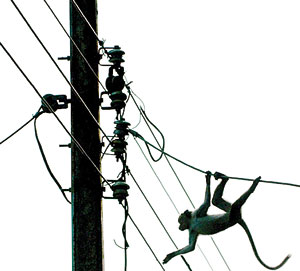News
Sacred site to be marred by overhead line
View(s):Archaeology chief backtracks on assurance. Wasantha Ramanayake reports
A new above-ground electricity line would run right through part of the Polonnaruwa World Heritage Site and not merely along its border, the Archaeological Department’s Director General, Dr. Senerath Dissanayake has admitted, contradicting his statement to the Sunday Times last week.

The struggling Ceylon Electricity Board (CEB), forced to increase tariffs this week to recover heavy debts, is engaged in a futile project to provide electricity to the Polonnnaruwa site which already has electricity, posing dangers to wildlife and blatantly violating environmental laws, this paper revealed last week, citing concerned residents and vendors.
Dr. Dissanayake said the new power line was being installed to keep the city secure for night visitors, and would be in operation by the end of the year. The sacred city is currently closed to visitors after 6 p.m. but it is planned that from the end of the year the site will be kept open at night.
It also runs contrary to Polonnaruwa District Secretary Wimal Abeysiri’s statement in last week’s story that the new power line was being set up to safeguard the sacred monuments from treasure-hunters. The CEB’s new line will run from the east of the ancient Rankoth Vehera northward towards another 12th century monument, the Gal Viharaya, through a narrow strip of forest on the eastern edge of the sanctuary.
The line then cuts through the centre of the forests north of the Gal Viharaya,and runs north through the western patch of forest towards the Thivanka Image House built by King Parakrama Bahu (1153-1186). Many trees have already been felled in the sanctuary cum sacred city, and the erection of new pylons will require the denuding of more forest.
Two power lines are already in existence, running along the sacred city’s eastern and western borders, providing electricity through an underground system to the ancient monuments. The planned new above-ground line will, in contrast, visually pollute the sacred city and pose dangers to the animals in the sanctuary, residents argue.
Under Section 7 of the Fauna and Flora Protection Ordinance, felling trees in a sanctuary is prohibited, environmental lawyer Jagath Gunawardane pointed out this week. “This is clearly going to lead to the destruction of animal habitat,” he said.
Dr. Dissanayake acknowledged that an underground system would be best but said an entire underground system would cost a large amount of money. “Neither the government nor any of the donor agencies showed interest in funding the project,” he said. He also said the CEB lacked qualified workers in Polonnaruwa to maintain an underground power system. There was no other alterative to but to go for this proposal which costs less, he responded.
Polonnaruwa residents point out, however that the new line could be laid underground along an existing road which is currently being paved and which runs through the sacred site. The Polonnaruwa site charges $US25 for an entry ticket for foreign visors, one of the highest fees in the country.
Mr. Gunawardene said running power lines through the Polonnaruwa sanctuary would threaten the lives of animals such as Hanuman and macaque monkeys, lorises, and also large birds such as peacocks.
“Lighting the paths in the sanctuary would certainly distract birds and animals such as nightjars and lorises that are nocturnal, he said.
Insects and certain spider species including tiger spiders (divi makuluwa) were attracted to light sources, he said. These lights would kill a large number of insects, and this would in turn affect the lives of pangolins, who depend on them, and birds such as fly-catchers.
The Wildlife Conservation Minister, Wijithamuni de Soysa, said that he was not aware of any new power lines being constructed in the Polonnaruwa sanctuary nor whether permission had been granted to do so.

A monkey asking for trouble
Attempts to contact Wildlife Conservation Department Director General Dr. H.D. Rathnayake were unsuccessful. While admitting that the new power line would run on pylons through part of the sanctuary, Dr. Dissanayake told the Sunday Times last Friday he was not aware of trees being cut down in the sanctuary to make way for the new line. He promised to inquire into the matter.
To cut down even a single tree, Mr Gunawardene said, the CEB should get an Environment Impact Assessment Report from the Central Environment Authority (CEA). The Sunday Times attempted to contact CEA chairman Dr. Wimal Rubasinghe to ascertain whether an assessment report had been obtained but was told he was out of Colombo.
Dr. Dissanayake said last week said that the new line – which he then maintained would not be constructed above-ground within the sacred city and sanctuary – would not visually pollute the ancient monuments.
“These electricity posts would be hidden in the jungle so that visitors could not see them,” he argued. “This power line would never blend in with nature and the ancient monuments,” responded a concerned archeologist who wished to be anonymous, pointing out that 20 years ago the authorities had been sensitive to the needs of the sacred site and the wildlife and had laid underground lines.
The global trend is to use lights more effectively, not over-lighting the monument with powerful lights but using concealed, diffused lights.
“The world heritage site is not only for the Sri Lankans but for the whole world,” he pointed out. “Why can’t we be creative and provide the sacred city with a suitable lighting system that would blend with the ancient monuments?”
Follow @timesonlinelk
comments powered by Disqus



















